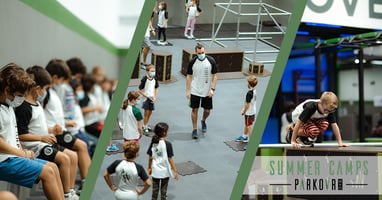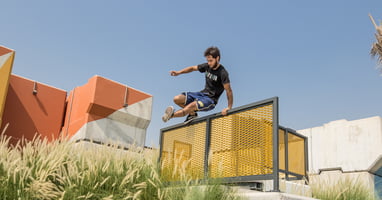We aim to offer more than just movement in all of our classes and services. By using a more...
Introduction to the Parkour DXB Academy Curriculum
Our first week is underway and our first students have been introduced to the new Academy Curriculum. Now, we know what kids are like – they don’t always give their parents the most comprehensive account of their day! So we have made this blog post to keep you up to date.
When we set out on this project we knew that we wanted the curriculum to be so much more than just ticking off a checklist of techniques – it should contain all the values and concepts that we want all of our students to embody at Parkour DXB, and also put the ownership into the hands of each student to be proactive in their training. We also knew that it would offer you, the parents of our students, the chance to better understand what we do and what we teach at Parkour DXB. So in that spirit, let’s break the curriculum down into its core parts.
Our Movement Pillars:
For a number of years now, our previous curriculum materials have been built around the four movement pillars of Parkour: Jumping, Climbing, Vaulting and Swinging. It is from these four basic categories that almost all other Parkour techniques are built. Each requires a unique set of skills and strengths to be performed at a high level and we feel that an equal measure of them all make for a well balanced athlete. Over many years we have mapped the journey for each of these movement pillars. Next we needed to bring it all together.
5 Units, 20 levels:
After some experimenting we have created 20 levels, which have been split further into 5 separate units. Each unit contains a theme of movement:
- Foundation
- Discovery
- Exploration
- Ascension
- Proficiency
The units are also designed to enable students of the four levels within that unit to train side by side, opening up opportunities for mentorship between our students. This allows the coaches to teach students of multiple levels within the same class, and means students can stay in the same class for longer, so they don’t have to keep changing their schedule!
How to Level up:
Our assessment process required a lot of thought. We wanted to ensure that our students are progressing and understanding the key techniques and principles of Parkour, without restricting their creativity, and still enabling them to bring their own style to their movement. In order to progress through each level, students will need to be able to:
- Demonstrate the techniques from the four movement pillars assigned to that level
- Show that they are able to complete the strength exercises with good form
- Answer one or more questions to show their understanding
- Complete a route that includes the techniques they have learnt within that level.
These four criteria are continually assessed during classes, Open Gym and even Camps. Students will need to demonstrate one or more of the criteria for the coach to tick them off in their Student Handbook.
One demonstration of a technique is not enough: students will need to have demonstrated their commitment to practice and refinement of the technique. We will cover how this works in a future blog post.
The Student Handbook will be for the students to keep and bring with them to all of their classes. It acts as their record of achievement but also enables them, and you, to look ahead and see what the whole of that unit has in store. There’s lots more information to take a look at inside the Student Handbook, with a glossary of the key words that the kids will learn during their classes – the perfect place for you to become familiar with what they are talking about!
Progressing to the next unit:
Progression to the next unit can only take place once the four levels within that unit have been completed. The fourth level in each unit contains a larger and more complex assessment compared to the other three, and therefore represents the biggest challenge to move up!
After completing a full unit, students are then invited to move up classes in the next unit. This enables them to continue to train with other young people who share a similar ability and commitment level. We will be sharing more information about this process in a future blog post.
More opportunities to practice:
We know many of our students will be excited and very keen to work their way up through the levels. The only way to do it is by regularly practising both inside and outside of their classes. This is a big part of what we mean by empowering our students to take greater ownership of their training. If they want to progress quickly, they are going to need to put the extra effort in. Currently there are 3 ways we would recommend doing this:
An additional weekly class
Attending two or three classes per week is a great way for students to commit to more practice. The classes are the cornerstone of our curriculum, where the bulk of the content will be taught, and the dedicated coaching offered in each of our classes is invaluable for students to make progress through the curriculum. We still recommend students to add a more independent aspect to their training, like the two options below.
Attending Open Gym
Students can attend one or more Open Gym sessions per week for a chance to use all of the equipment in our full studio space at their own leisure. Open Gym takes place on weekdays from 7:30pm onwards, and on Saturdays from 12pm to 2pm, at our Academy in Al Quoz. In Port Rashid, we have one Open Gym session on Tuesdays from 7:30pm. Open Gym is the perfect place for students to take their practice into their own hands, with full access to the academy to practice their skills and train with friends. A full term Open Gym membership is just AED 500 so it’s also a great cost-effective option for unlimited training!
Practicing at home or at the park
We recommend that students practise as much as possible in their own time. Parkour is a sport built on the idea that it can be practised anywhere. Your kids can practise at home or in the park, as long as they are mindful of their ability and confidence level and stick within their comfortable level of risk. In particular, practising the strength criteria for their current level at home will be a great advantage to their progress.
Just the tip of the iceberg:
Who knew so much went into a Parkour class? And this is just the tip of the iceberg! We will continue to post and dive deeper into specific elements of the curriculum and our coaching philosophy in the coming weeks and months. We hope that you are all as excited as we are to see the curriculum being shared and looking forward to what your kids will achieve with this support structure behind them.
As always we would love to know your thoughts so please feel free to get in touch and let us know your feedback. See you at the Academy!


.jpg?height=200&name=5-benefits-kids%20(1).jpg)